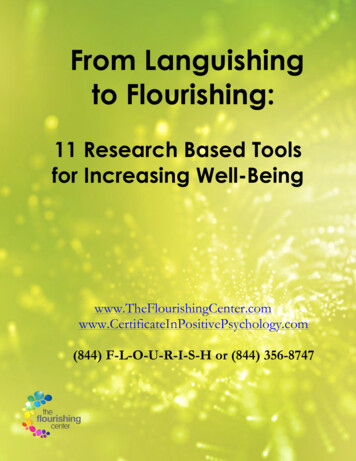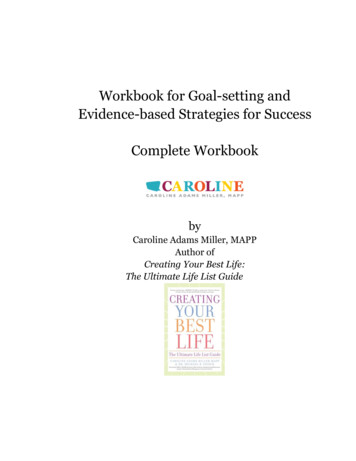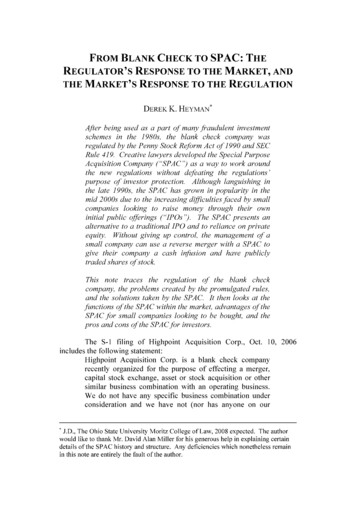
Transcription
From Languishingto Flourishing:11 Research Based Toolsfor Increasing ateInPositivePsychology.com(844) F-L-O-U-R-I-S-H or (844) 356-8747
Dear Flourisher,A 2002 study by Dr. Corey Keyes from Emory University asked a simple yetprofound question.[29] Of the general population, how many peopleare mentally ill, healthy or flourishing? The results are prettyastounding.Here’s what he found. Of the 3,032 participants in the study, only 17.2%of people were flourishing. Then 56.6% were moderately mentallyhealthy, 12.1% percent were languishing and 14.1% fit the DSM criteria formajor depressive disorder.It gets better. Up until recently, most psychology research focused on howto get that depressed population less depressed. “What about themajority of people who aren’t depressed?” you ask. Great question!That’s exactly what the field of Positive Psychology is all about. It is alsoexactly the kind of information you’re going to receive from us here at TheFlourishing Center where we are dedicated to your personal andprofessional flourishing.This eBook contains 11 practical and proven tools to move peoplefrom languishing to flourishing.“What does it mean to belanguishing?” It’s like that feeling you get when you get in your car and startdriving only to realize you’ve left the emergency brake on. You know thatuncomfortable feeling of working but feeling like you’re not really gettinganywhere and everything feels hard. You’re not quite depressed, but yousure aren’t happy.The tools I’m about to share with you have been proven to support people inmoving “north of neutral” in their life before they get clinically depressed.I encourage you to share this eBook with your friends and family.The more tools we all have in our tool kit for creating happier and healthierlives, the better. As my teacher would say, “If you only have a hammer, youtreat everything like a nail.”I hope these tools become empower you the way they have empoweredmyself and the thousands of people we’ve been sharing this with.With love and light,Emiliya Zhivotovskaya, MAPP, PCC, ERYTFounder & PresidentThe Flourishing CenterP.S. Did someone send this eBook to you? Stay in the know by signing upto our newsletter at www.theflourishingcenter.com.
Table of Contents1.2.3.4.5.6.7.8.9.10.11.Oxytocin: The Hormone of TrustFear: Why it Feels Good to WorryMake Friends: You’ll Live LongerSavoring: The Deliciousness of LifeYour Work: Job, Career or Calling?Exercise: Mammals Have to MoveBreathing: For Calm and HealthPrimers: Counter Out of Sight, Out of MindGratitude: Social GlueSelf-regulation: Flex this MuscleSelf-efficacy: Beyond Self-Esteem 2015TheFlourishingCenter3
1. Oxytocin: The Hormone of TrustOxytocin is a neurotransmitter that acts as a hormone. It is well known for beingreleased during breast feeding, but it is also released during orgasm, hugs, snuggling,holding hands, partner dance, massage, body work and mental imagery of closeness[1]. Oxytocin plays an essential role in living a flourishing life.Oxytocin is the hormone of social bonding and it facilitates trust. It tells the brain,“I’m okay. Everything is alright.” When oxytocin is present in the body, brain scansshow less activity in the amygdala, the emotional center of the brain that processesfear and anxiety [2]. It reduces blood pressure and lowers cortisol levels [3]. Theoxytocin supported state shifts you away from fight-or-flight survival mode intofeeling more calm and less stressed. Studies show that oxytocin improves couplecommunication [4]. Research also shows oxytocin increases prosocial behavior [5],meaning that people are more giving and trusting when it is present in the body.Trust is key for enhancing the positive in your life. Imagine sitting down to mediate.You close your eyes. Where does your mind immediately go? Probably a thought ofsomething you have to do or of something someone said. The key to getting yourmind to quiet down is to invite in calm,trust and your own oxytocin. Otherwise,your mind says, “Don’t just sit there, dosomething.” Quieting your mind requiresreassuring it, “It’s okay. Life is good. Wecan be calm and still for a little while.”Here are five things you can do to boostyour well-being and stimulate your body’srelease of oxytocin (partner not includedand not necessarily needed J ):1.Spend time visualizing and feeling appreciation, love and affection for peopleyou care about. Just thinking about the person isn’t enough; feeling the“closeness” facilitates the emotional and hormonal shift.2. Get massaged and cuddled. Babies that are not touched do not develop as well asthose who are. We have a biological need for closeness. Don’t have a lovingpartner for intimacy right now? That’s fine. There is so much healing and wellbeing available through massage and body work from trained, lovingprofessionals.3. Practice rhythmic patterns of both breath and touch to help bring the body intoa state of greater coherence and calm. Simply dancing and moving in a repeatedpattern can induce a more meditative state which tells your brain, “Everything isokay.” When performed from a space of love and self care, stroking your own hairor skin with a dry brushing technique can release oxytocin. The same thingworks for petting pets.4. Work with mantras or affirmations such as “I trust,” or “I’m okay. Whatever lifebrings me, I will work through it. I have in the past I will in the future.”5. Use the power of visualization combined with breath work by imagining a wordor image that induces a sense of calmness and connection with others such as “Iam loved.” Breathing is a powerful tool for stimulating the parasympatheticsystem (the part of the autonomic nervous system associated with calm, rest anddigestion). 2015TheFlourishingCenter4
2. Fear: Why it Feels Good to WorryMost of us think that worrying is a bad feeling. Fear, anxiety and worry all fit underthe umbrella of emotions linked to the belief that something bad might happen.Your brain sends messages to you to worry, and plans for worst case scenariosbecause it wants to protect you from future harm. But there is another reason whyyour brain does it: from your brain’s perspective, worrying about the future actuallyfeels good. That’s right, it feels good.In the book, Mapping the Mind, science writerRita Carter says, “part of the brain’s internalenvironment is a ceaseless pressure to seek outnew stimuli and to gather information,especially about future events [creating a]feeling of pleasurable anticipation” [6].Researchers Ethan Martin and OkihideHikosakafound that gathering informationabout the future activates the neurotransmitterdopamine in the brain [7]. Dopamine alsofunctions as a neurohormone. It is associated with the pleasure centers of thebrain, producing a sense of enjoyment and motivation to repeat certain behaviors.It gets released during enjoyable experiences such as eating and having sex.Your brain is biologically wired for survival. As it ruminates about the future andgathers information, it releases dopamine to say, “Good job, keep me safe, stay alertto the worst things that could happen.” This inclination was important thousandsof years ago when our ancestors faced life threatening conditions. However,nowadays most of the things you worry about are not likely to happen. Instead,worrying increases your stress and decreases your well-being.Here are practical ways to redirect your brain from its masochistic tendency tostress and worry:1.Catch yourself when you are ruminating or catastrophizing about the future.Identify what that voice sounds and feels like. Call it for what it is a habitualpattern of thinking and thank it for its reminder and desire to keep you safe.This type of acknowledgment and acceptance often makes the tendencydiminish significantly.2. Remind yourself that the worries and catastrophic thoughts are probablyunfounded. These thoughts are just your brain not having anything else to getits dopamine fix. That doesn’t mean you need to go stuff your worry with foodor sex (although if you do it in reasonably healthy amounts enjoy!).3. Use your brain’s desire for novelty seeking and future-mindedness to think ofthings that you want instead of what you don’t want. You’ll get a similardopamine release in your brain, feel less stressed out and most importantly,your brain will focus on manifesting what you want. 2015TheFlourishingCenter5
3. Make Friends: You’ll Live LongerIn 2010 a research study was conducted questioning whether having friends madepeople live longer. Psychologist Julianne Holt-Lunstad and her colleaguesconducted a meta-analysis (a study that utilizes the data of many studies to test ahypothesis) of 308,849 participants and their mortality [8]. Those who hadstronger social connections had a 50% greater chance of surviving regardless oftheir age, gender, initial health or cause of death! That’s all the more reason to go toyour next high school reunion, right?Why does this happen? Nature/evolution rewards behaviors which promotesurvival of the species. Throughout evolution, being social and working incommunity increased survival odds. Thus, positive chemical changes occur in thebody to encourage the body to repeat these behaviors: Natural killer cells are produced to increase immunity Feel-good hormones such as oxytocin and dopamine are released Cortisol, the stress hormone, decreases Artery functioning and mental performance improve The risk of heart disease, cancer, stroke and dementia decreasesDespite the increased evidence that social connections are important, a study in2006 revealed a three-fold increase within 20 years of the number of peoplereporting they do not have a confidant [9]. Even worse, according to Dr. AricSigman, the amount of face to face time people get has fallen dramatically since1987 [10]. In this digital world, there is a greater need now than ever for authenticconnections. They can save your life!Here are a few tips for expanding or richening your social network:1.Identify and write down beliefs or judgmentsthat might stand in the way of you connectingwith people. For example: “People don’t wantto talk to me,” or “I never know what to say topeople.” Beliefs influence what you do andhow you feel about yourself. Work with acoach to redirect your beliefs.2. Make social connection a priority. Createmore space and time in your life to do thingsthat are meaningful for you and connect withothers who do the same.3. Coordinate a gathering inviting friends tobring their friends. Potlucks, board games, Wii Challenges and vision boardingparties are some ideas. Make it active, which is more likely to create a flowingexperience, rather than passive entertainment, such as watching a movie.4. Join www.meetup.com, a free online network that brings people together whoare interested in similar topics. Simply type in your zip code and find eventsand opportunities to make friends in your area. Can’t find a topic you’reinterested in? No worries, it’s quick and easy to start your own group! 2015TheFlourishingCenter6
4. Savoring: The Deliciousness of LifePositive emotions are a key component of flourishing. One simple and powerfultool for increasing your positivity is actively savoring the experiences of your life. Ilovingly refer to this as “Falling in love with the deliciousness of life,” or “You’rehere, might as well get the most out of it!” Savoring is a form of alchemy; bysavoring you can instantaneously transform a mundane experience into one thatboosts your positivity.Savoring is defined as being attentive and appreciative of an experience. Savoringis a form of mindfulness. Bryant and Veroff, leading researchers in this field,identify three forms of savoring: anticipatory (looking forward to something in thefuture), attentive (using your senses to be mindful of it in the present) andretrospective (reminiscing positively about a memory) [11].Savoring involves inducing a positive emotion. Where mindfulness involves beingvery present to an experience, reminisicing allows you to conjure up a memory. Inorder to savor, look for the beauty, fun, smile, joy, warmth and meaning behind anexperience.In and of itself, savoring is not difficult to do. Thechallenge is to rememeber to do it. The use of primersor reminders accessible to your eyes and ears is key. Irecommend Post-it notes, signs, phone alarms orverbal cues from friends. Over time, savoring practicescan become more habitual.Here are tips for upping your experiences of savoring:1.Set aside the time for a slow and indulgent meal.Try engaging all five senses as you do so. Timeyourself. How long can you stretch the experiencefor?2. Set an alarm on your phone to go off at random times throughout the day.When it goes off, find something in your environment to savor.3. Withdraw from your sense of sight and increase the experience of your othersenses. Have a friend blindfold you and walk you around town, feed you a mealor sit with you in nature. 2015TheFlourishingCenter7
5. Your Work: Job, Career or Calling?If you work a 40-60 hour work week, you spend 36-54% of your waking hoursworking. When you factor in the amount of time you spend commuting to work,thinking about work, talking about work, stressing about or ruminating onconversations from work, that number might be as high as 70 !Research by psychologists Amy Wrzesniewski and Jane Dutton [12] shows there arethree ways people orient themselves to their work: Work as a job: You do it because you have to. You’re motivated by the moneyor other work benefits. When off the clock, you don’t think much about work. Work as a career: You are motivated by both the benefits of work (monetaryetc.) and the status symbols (promotions, titles, advancement etc.). If yourwork wasn’t supporting your ascension towards a better position in the future,you might not do it. Work as a calling: You love your work, and it is meaningful to you. Youappreciate being paid for doing it, however, you often say, “I’d do my work forfree.” You think about your work outside of work hours, not because you’re aworkaholic, but because your work brings you joy, engagement and purpose.Research shows that people who view their work as a calling score higher on workand life satisfaction. Here are three processes for creating more meaningful workrecommended by researchers Amy Wrzesniewski and Jane Dutton:1.Make a cognitive change: Change your perceptions of your work. How doesyour work affect the world at large? How is your work a necessary part of agreat functioning whole?Example: A flight attendant reinforces the belief that her job is to ensure thatcustomers feel safe and comfortable on their flight, rather than believing herjob is simply to give people drinks and pretzels.2. Change your task orientation: Find things to do at work that are challengingand beneficial to you and/or the company.Example: A parking attendant creates a moreefficient way to track the parked cars making iteasier for his colleagues and making thecompany more effective.3. Focus on relational aspects of your work:Create more opportunities to interact withpeople at work, and feel how the job you dobenefits them.Example: College honor society administratorsget to interact with the students that benefitfrom their services and hear their successesand expression of gratitude. 2015TheFlourishingCenter8
6. Exercise: Mammals Have to MoveHere’s a test. How many of the following describe you: (1) you’re warm blooded, (2)your offspring are born alive, (3) you have hair/fur on your body, (4) you havevertebrae, (5) you have lungs to breathe air and (6) you consumed mother’s milk asa baby. Hopefully you answered yes to all of these statements (unless you’reundergoing some major laser hair removal J ), which means you’re a mammal.Being a mammal means you are wired for a lot of movement and physical activity.Homo sapiens like you and I have been roaming this planet for 250,000 yearstrying to find ways to survive. Modern agriculture began just 8,000 years ago,which decreased our need to forage for food over time [13]. Evolution/naturerewards patterns that enable survival. Thus a number of chemical changes happenin your body when you exercise, including ones that boost your mood, cognitivefunction and immune system.Exercise increases the presence of endorphins three to ten times more than periodsof low physical activity. A study by Babyak et al., demonstrates that exercise is aseffective as antidepressants and has significantly lower relapse rates [14]. Theeffects of exercise on mood are so strong that Dr. Tal Ben Shahar, the renownedHarvard “Happiness Professor”, says that not exercising is like taking a depressant[15]! A study of 8,000 participants also found that exercisers were significantlyhappier and more satisfied with their life than non-exercisers [16].Exercise improves working memory and attention [17] boosts the presence ofdisease fighting cells in the body, increases the production of growth hormone (thebody’s mechanism for regenerating cells) and increases the presence oftestosterone (Men, you won’t need Viagra!).Here are tips for seamlessly integrating more physical activity into your daily life:1.Maket fun, and do something you love. I havefound a style of dancing that kicks my butt, butit’s so much fun to do that I forget I’mexercising.2. Create opportunities to turn daily activitieslike clinbing stairs, cleaning and walking intoexercise. Make it brisk and invigorating!3. Get other people involved. Whether it beexercising with people or supporting eachother’s fitness goals, social support makesexercising exponentially more enjoyable. Checkout phone apps like Cardio Trainer that let youlog your workouts and share them with friends.4. Keep at it until it becomes consistent andhabitual. 2015TheFlourishingCenter9
7. Breathing: For Calm and HealthYou came into this world taking your first breath, and one day your breath will stopand you will leave this world. The oxygen flowing into your body and out in theform of carbon dioxide, is your life force energy. Not only does breathing fuel everycell of your body, it is intimately connected to your autonomic nervous system. Bylearning to regulate your breath, you can master calming or invigorating yourself.Breathing influences your heart rate variability (HRV), which is the variationbetween your heart beats. Taking deep inhales and long, slow exhales increasesyour HRV, which is positively correlated with good health [18].When most people tune into their breath, they find that it tends to be short andshallow. This is because many people only breathe into their throat and upper chestinstead of deep within their diaphragm. This keeps HRV low. When you getstressed, it gets even lower. One way to improve HRV, get more calm and morewell-being is to slow and deepen your breathing.Here are simple tools for working with your breath:1.In for 5 out for 5, is encouraged by Stephen Elliot in his book, The New Scienceof Breath [19]. Inhaling for a slow count of 5 and exhaling for a slow count of 5brings you down to 6 breathes a minute where most people usually breathe 15.A ratio of 5:5 has been proven to reduce HRV in just minutes.2. Belly breathing refers to using your diaphragm, also known as your third lung,when breathing. Visualize a balloon in your stomach that you fill with breath asyou inhale and exhale.3. Calm yourself when you’re stressed out or anxious by breathing at a ratio of1:2, inhales to exhales (i.e. If you inhale for 3 counts, exhale for 6). Start slow.The more stressed or anxious you feel, the less natural it will feel to breathe thisway. Start with in for 2, out for 4. Then progress to 3 or 4 counts to inhale andexhale for 6 or 8 counts. Repeat for at least 10 cycles. For a calm meditativestate, try it for 5-10 minutes.4. Invigorate yourself when you’re tired or low energy by breathing at a ratio of2:1, inhales to exhales (i.e. If you inhale for 6, exhale for 3). Start slow becauseyou are flooding the body with rich oxygenated blood. A minute worth ofinvigorating breath maybe plenty. For advanced breathing techniques, workindividually with a teacher.Images: Left- displays HRV at 5 breathes per minute. Right- displays HRV at 15breathes per minute [19]. 2015TheFlourishingCenter10
8. Primers: Counter Out of Sight, Out of MindWhen you first set a goal there is a lot of energy around it. That energy is bound tofade quickly as time passes, particularly if the goal takes time and is multi-faceted.The saying, “Out of sight, out of mind,” rings true. It is much harder to staycommitted to your goals with no visual reinforcement. Psychologists use the termprimer to refer to conscious or unconscious cues that are paired together to create abehavioral change.Many experiments have demonstrated that primers have a measurable effect onbehavior. One study used an image of an athlete crossing the finish line to prime asuccess mindset for rookies doing fundraising. The study showed that the use of aprimer lead to as much as an 85% increase in the amount of money raised [20].Here are examples of primers that you can pair with your goals:1. Post-it notes or other signs2. Passwords to frequently accessed sites (i.e.“Lose10in2011”)3. Bracelets with charms or reminder words4. Ring tones or alarms on your phonereminding you to do your goal5. Vision boards or posters6. Computer wallpaper or screensavers7. Voicemails of your own voice remindingyou of your goalDespite your attempts to use primes, its effectscan wear off as you adapt to the prime. (i.e.Your “Stay Mindful” bracelet becomes someband you have on your wrist.)Rotate yourprimers trying to create novelty, and thus, moreenergy around your goals.Image reference [21] 2015TheFlourishingCenter11
9. Gratitude: Social GlueResearch shows that gratitude is one of the most powerful and instantaneous waysto get into a more positive state [22]. People who practice gratitude are healthier,live longer and feel younger. From an evolutionary perspective, gratitude serves associal glue. Someone does something good for you, you say thank you. Thiscommunication encourages the good doer to do more good for you. The feeling ofgratitude fills you. Through your biology, your body speaks to you and says, “Life isokay. Good things happen to me.”Gratitude is fundamental for forming relationships. Imagine you go out with a fewfriends and the following day you get a message from one of them saying, “Thanksfor coming out last night. It was great to see you!” How would you feel? Chancesare you’d feel good and want to see that person again. Gratitude is not justfundamental courtesy. When it’s used above and beyond basic manners, it can beused to help people feel closer to you, like you more and want to do more goodthings with and for you.Grow Your Gratitude:1.Be on the lookout for good things that happen to you. Start by feeling thegratitude before you even attempt to express it ( people can spot a phony).2. Look for details in the positive things. Details enhance the experience ofgratitude. Think of the people who bring good things into your life.3. Look for things that you usually give thanks for, and add an extra touch ofgratitude. My father always picks me up from the train station when I visit. Ialways say, “thanks” at the end of the car ride. Last time I sent him a textmessage with my added gratitude once I was on the train.4. Change up the words. In addition to “thanks,” there is also, “I appreciate it.”“I’m grateful.” “It means a lot to me.” “Thank you for .” “ x has made mefeel y , thank you.”5. Keep a gratitude journal of the things that you feel blessed by. This makes fora great resource to turn to on days when feeling grateful is harder to access.Simply go back and read through the positive events. 2015TheFlourishingCenter12
10. Self-regulation: Flex this MuscleAccording to Dr. Sonja Lyubomirsky, intentional activities (what you think, feel anddo) account for 40% of your happiness [23]. Making your activities align with howyou want to show up in the world requires self-regulation.Here are two examples: Sally sets her alarm for 6:30 a.m. with the intention to wake up and go to thegym. The alarm goes off. She tells herself she’s going to close her eyes for fivemore minutes, only to get up an hour later.Jim set the intention of avoiding sweets except for one “cheat day” a week. It’sTuesday and the temptation for a cupcake hits at the office. He tells himselfhe’ll use his one cheat for the week. Friday comes along, and he is out to dinnerwith friends. Everyone orders dessert, so he does as well. He rationalizes bysaying, “I’ll start that intention next week.”Not exercising one morning or eating an extra dessert won’t hurt Jim or Sally. Thechallenge to their happiness is telling themselves they will do one thing and actuallydo another. This easily turns into a pattern of rationalizing one’s way out of doingthings that are challenging or sacrificing short term pleasure for long term gain.Research by Dr. Roy Baumeister shows that self-regulation is like a muscle [24].The more often you use it, the stronger it gets. Self-regulation is also finite like amuscle; it gets fatigued after many repetitions and needs replenishing. Researchshows that self-regulation is correlated with control over one’s emotions,achievement and goal setting success, empathy and happiness.Lacking will-power or self-regulation comes from frequently giving in to a habitualway of acting, thinking or feeling. Reclaim your happiness by creating spacebetween your impulses and actions. Here are research-based tips to improve selfregulation:1.2.3.4.5.6.Use primers (see #8) when setting goals, and beaccountable to other people.Example: Put signs up reminding you our yourgoal, and tell a friend about your e: Strike up a conversation with someonerather than making a second trip to the desserttable at a party.Reframe the temptation as something lessdesirable.Example: Think, “That chocolate fountain isn’tchocolate, it’s dog poo!”Avoid the temptation all together.Example: Download the Facebook Limiter software. It turns off your ability toacces the site except during pre-determined times.Objectify the object of temptation.Example: Imagine a frame around the thing you are resisting. Tell yourself itisn’t real and it is a picture of the thing you want to resist.Create an “If then ” statement around your intention.Example: If I start feeling tempted to check my e-mail instead of working onmy book, then I will remind myself of the book’s importance and that I’ll have ahalf hour to check e-mail once I’m finishedImage reference [25] 2015TheFlourishingCenter13
11. Self-efficacy: Beyond Self-EsteemThere’s a strong yet subtle difference between self-esteem and self-efficacy. Selfesteem is a sense of feeling good about yourself, i.e., “I feel good about myself! Selfefficacy is a belief in your ability to utilize your skills in a given circumstance, i.e., “Ican do this!” Self-esteem is one component to having healthy self-efficacy.Research shows that people with high self-efficacy [26]: Have stronger feelings of control over their thoughts, feelings and actions,which are essential to well-being. Feel less helplessness, anxiety, stressand depression. Are more likely to adopt healthybehaviors and stop unhealthy ones. Have more feel-good chemicalsreleased in their brain such ascatacholamines (manage stress fromthreats) & endorphins (naturalpainkillers). Have higher self-regulation (see #10). Achieve their goals more often and set goals that are loftier and more effective. problem solving and decision makingHere are some tools to help you become more self-efficacious:1. Identify and remove negative beliefs about having high self-efficacy. Selfconfidence is different than self conceit. A healthy dose of self-efficacyincreases your success and productivity.2. Reflect on the strengths that you have. Take questionnaires such as the VIASurvey [27] to give you the words to describe your strengths.3. Reflect and write down what you have accomplished. Drawing on your pastexperiences to feel good about your present!4. Recognize that self-efficacy is a spiral of self-fulfilling prophecies. When youhave positive expectations for your abilities, you’re more likely to accomplishyour goals. In accomplishing goals, your self-efficacy increases. Since it’s aspiral, you have to start somewhere.5. Remember that you can handle it. In Susan Jeffers’ book, Feel the Fear and Doit Anyway [28], she reminds us that the key to tackling our fears about our selfworth is to remind ourselves that “anything that has ever come [my] way,[I’ve] handled it!” And since you’ve handled it in the past, there is no logicalreason for you to not handle it in the future! 2015TheFlourishingCenter14
References1. http://en.wikipedia.org/wiki/Oxytocin2. Domes, G., et al. (2007). Oxytocin attenuates amygdala responses to emotional faces regardless of valence. BiologicalPsychiatry, 62,10, 1187-1190.3. Grewen, K.M., Amico, J., & Light, K.C. (2005). Effects of partner support on resting oxytocin, cortisol,norepinephrine, and blood pressure before and after warm partner contact. Psychosom Medicine, 67(4):531-8.4. Ditzen, B., et al. (2009). Intranasal Oxytocin Increases Positive Communication and Reduces Cortisol Levels DuringCouple Conflict. Biolog Psychiatry, 65, 728-73.5. Mikolajczak, M., et al. (2010). Oxytocin not only increases trust when money is at stake, but also when confidentialinformation is in the balance. Biological Psychology, 85,1, 182-184.6. Carter, R. (2010). Mapping the mind. University of California Press: Los Angeles.7. Martin, EBS, and Hikosaka, O. (2009). Midbrain Dopamine Neurons Signal Preference for Advance Informationabout Upcoming Rewards. Neuron, Volume 63, Issue 1, 119-126.8. Holt-Lunstad, J., Smith, T.B., & Layton, B. (2010).
partner for intimacy right now? That's fine. There is so much healing and well-being available through massage and body work from trained, loving professionals. 3. Practice rhythmic patterns of both breath and touch to help bring the body into a state of greater coherence and calm. Simply dancing and moving in a repeated










